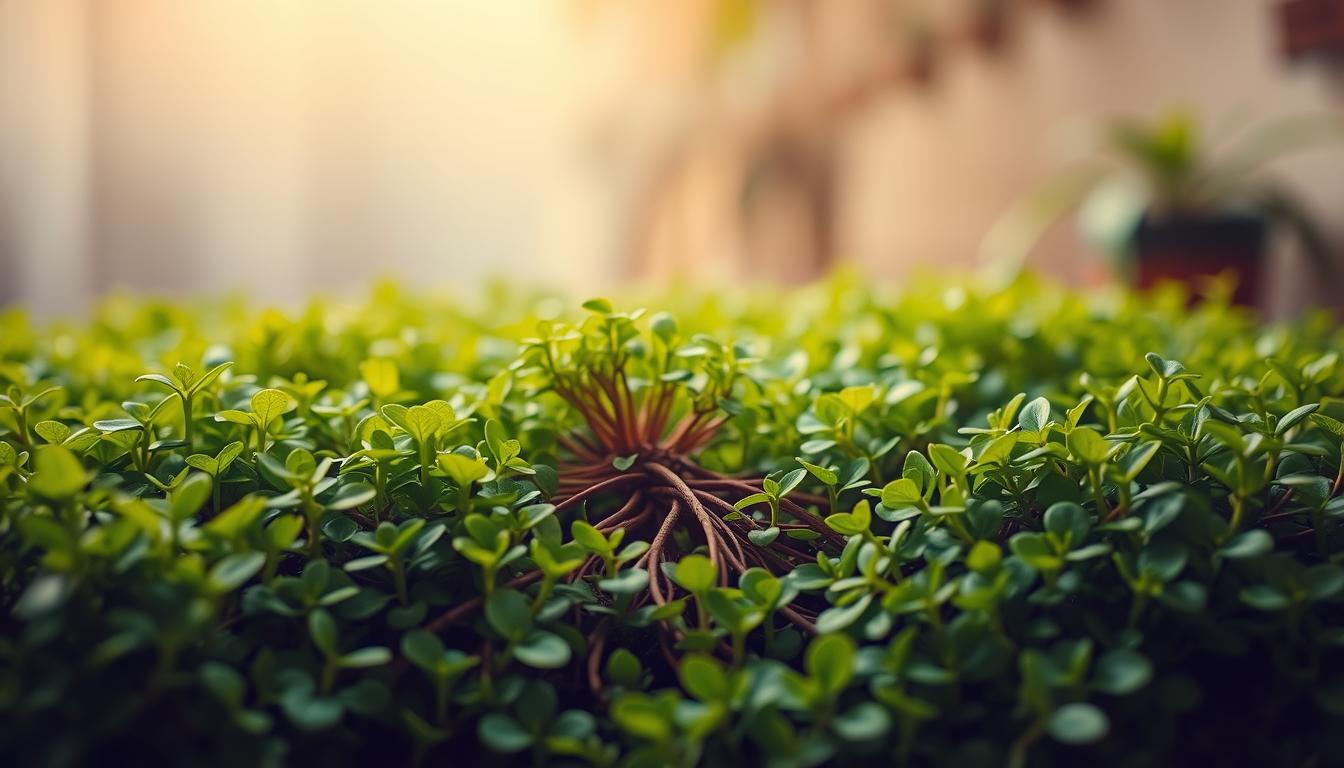Looking to add some nature to your home or office? A carpet plant is a great choice. These plants are easy to care for and can grow well in many conditions. They have dense leaves that can clean the air, make rooms quieter, and look beautiful.
So, what makes carpet plants so special? Can they really make your space feel alive and clean the air? Yes, they can. Carpet plants are perfect for anyone wanting to add greenery indoors. They come in many styles to fit your taste and needs.

Table of Contents
What is a Carpet Plant?
When you think of adding a new plant to your space, you might wonder about “carpet plants.” So, what are they? Carpet plants are plants that spread out to cover the soil. They make great garden carpeting and plant for landscaping. Their dense foliage creates a lush look.
Carpet plants are great because they stop weeds and prevent soil erosion. They’re also easy to care for. This makes them perfect for those who want greenery without hassle. Popular carpet plants include creeping thyme, sedum, and phlox. They come in different colors and textures, adding beauty to your landscape.
Choosing the right carpet plant can be fun. Here are some popular ones:
- Creeping thyme: a low-growing, spreading plant with tiny leaves and flowers
- Sedum: a succulent plant with thick, fleshy leaves and stems
- Phlox: a flowering plant with fragrant, pink, purple, or white blooms
Knowing about carpet plants and their types helps you pick the best one. Whether you want to add color or stop weeds, carpet plants are a good choice.
Benefits of Having Carpet Plants
Carpet plants, like creeping plants and perennial ground covers, bring many benefits to indoor spaces. They help purify the air by removing harmful toxins. This makes your environment healthier and more welcoming.
These plants also help reduce stress and improve mood. They add natural beauty with their vibrant colors and textures. This creates a calm and serene atmosphere in any space.
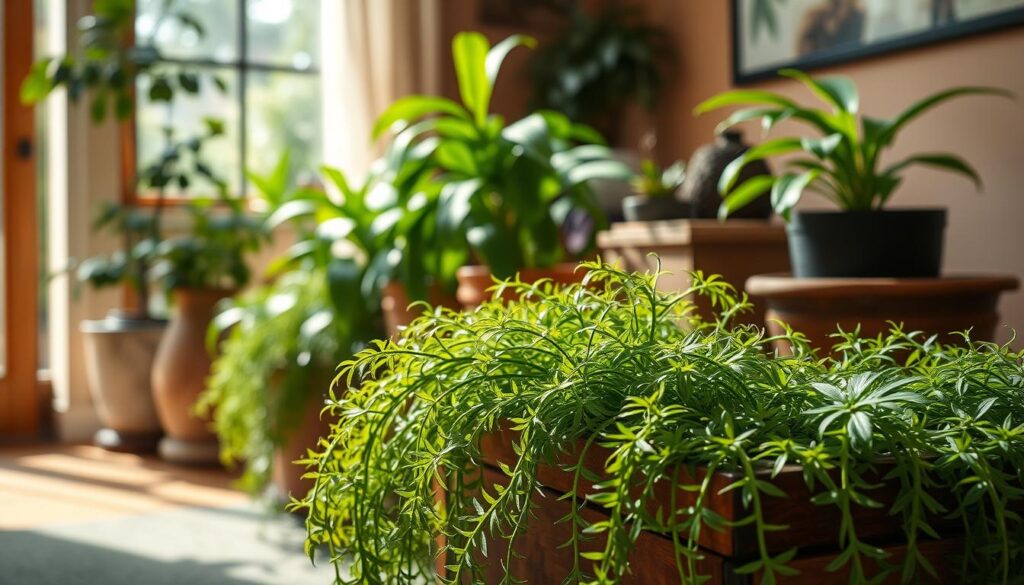
Carpet plants are great for hiding unsightly areas or filling gaps in landscaping. They help create a sense of continuity and cohesion. This makes a space feel more welcoming and inviting.
Some popular carpet plants include Glossostigma elatinoides and Dwarf Hairgrass. They thrive in different lighting conditions. Overall, carpet plants are a wonderful addition to any indoor space. They improve both physical and mental well-being, creating a more natural and relaxing environment.
Ideal Conditions for Carpet Plants
To make your carpet plants happy, you need to know what they like. They do well in many light conditions, from full sun to partial shade. This makes them perfect for low growing plants and garden carpeting. They’re also great for plant for landscaping because they can handle different lights.
Carpet plants need 8-10 hours of light a day to feel like they’re in the sun. The soil’s pH should be about 6.8 to help them grow well. Using rich soil, like UNS Controsoil, helps them get the nutrients they need.

- Keep CO2 levels between 20-30 ppm for best growth
- Give them strong overhead light for compact growth
- Use a thin layer of soil, about 1 to 2 inches, with a top layer of 1/3 to 1/2 inch
By meeting these needs, you can make a great home for your carpet plants. They’ll do well in garden carpeting or as a plant for landscaping. With the right care, your low growing plants will thrive, and you’ll get to enjoy their beauty.
How to Care for Your Carpet Plant
To keep your carpet plant happy, you need to know what it needs. It needs the right amount of light, water, and food. Dense foliage plants like carpet plants need careful care to stay healthy and look good.
Don’t overwater your carpet plant. Too much water can cause root rot. Make sure the soil is moist but not too wet. The soil should drain well, like a potting mix made for plants that spread out.
For creeping plants like carpet plants, a balanced fertilizer helps them grow well. Use a fertilizer that dissolves in water during the growing season.
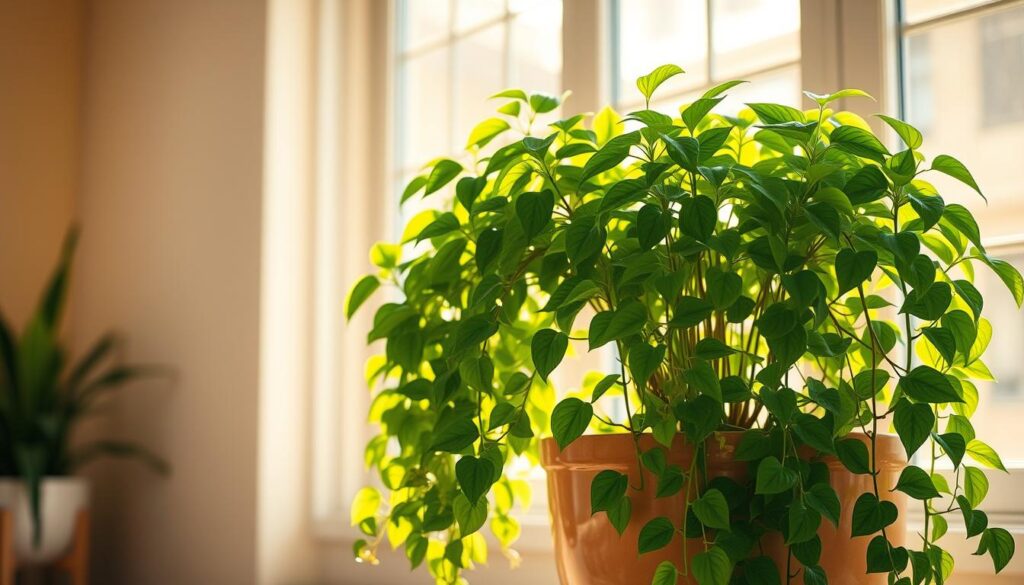
- Providing adequate light, with a PAR value of above 50 Umols at substrate level for optimal growth
- Maintaining a shallow tank, with a recommended depth of 12 inches or less, to allow for better illumination at substrate level
- Using a high-quality aquasoil, such as UNS Controsoil, to provide essential macronutrients for optimal growth
By following these tips, your carpet plant will do great. It will spread out and cover the ground. This helps stop weeds and keeps the soil in place.
Common Pests and Diseases
When you care for your carpet plants, it’s important to watch out for pests and diseases. Look for signs like spider mites, mealybugs, and root rot. These can harm your low growing plants.
Spotting these problems early can stop them from getting worse. Look for white powdery patches, sticky leaves, or soft, black roots. To keep your plants safe, use clean potting mix, don’t overwater, and keep new plants separate.
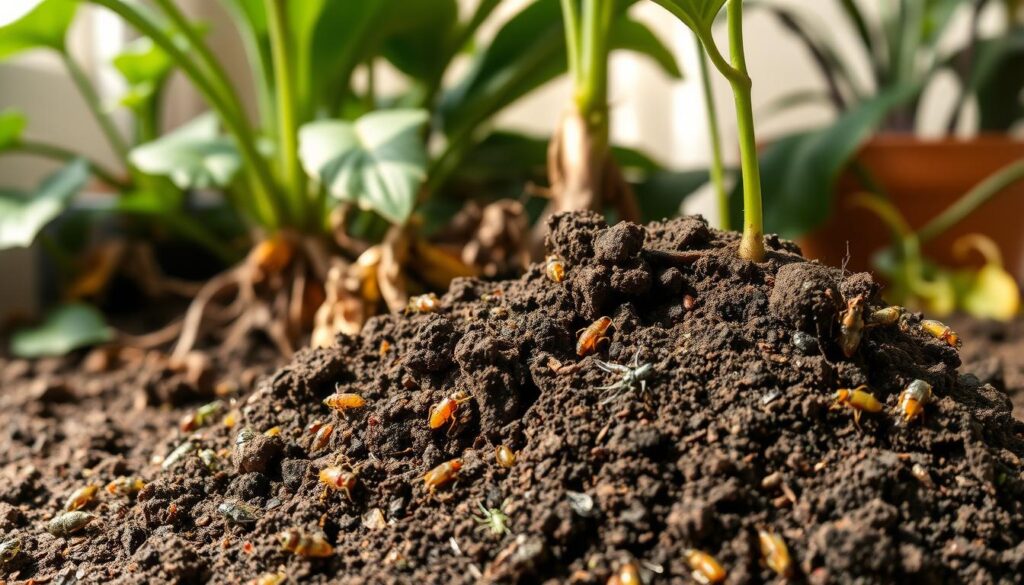
Identifying Common Issues
- Yellowing leaves can indicate overwatering or nutrient deficiencies.
- Stunted growth may result from underwatering or poor soil conditions.
- Wilting or drooping leaves can signal overwatering or underwatering.
Preventative Measures
To keep your carpet plants healthy, water them regularly and use soil that drains well. Check the roots every 2-3 months to catch root rot early. Also, introducing natural predators like ladybugs for aphids can help.
| Pest/Disease | Symptoms | Prevention |
|---|---|---|
| Spider Mites | Fine webbing, stippled leaves | Regular inspection, isolate infected plants |
| Root Rot | Wilting, soft blackened roots | Well-draining soil, avoid overwatering |
Decorating with Carpet Plants
Carpet plants can make your home look lush and green. They are not just useful but also add beauty to your decor. You can use them as a ground cover or hang them to green up your walls.
Mixing carpet plants with other plants like dense foliage plants adds depth and variety. Pairing them with taller or flowering plants makes for a stunning display. Carpet plants are great for small spaces or big areas, adding beauty wherever you place them.

Carpet plants can be the centerpiece of a table or a lush carpet underfoot. They also look great on walls or in baskets. With a bit of creativity, you can make a unique display with carpet plants and other greenery.
Here are some tips for decorating with carpet plants:
- Choose plants that match in texture and color
- Think about the plants’ light and temperature needs when picking a spot
- Use plants with different growth habits for a unique look
Follow these tips and get creative with carpet plants and other plants like carpet plant and dense foliage plants. Pick plants that fit your home and lifestyle. Don’t be afraid to try new things.
Propagation Techniques for Carpet Plants
Exploring carpet plants can be exciting. You might want to share these creeping plants with friends or grow more in your garden. Propagation is a fun way to do this. You can use stem cuttings or division to create new plants.
Before starting, learn the basics of propagation. Soil cover plants like carpet plants need the right care. Make sure they get enough water and light until they settle in. With the right techniques, you can grow your carpet plants for years.
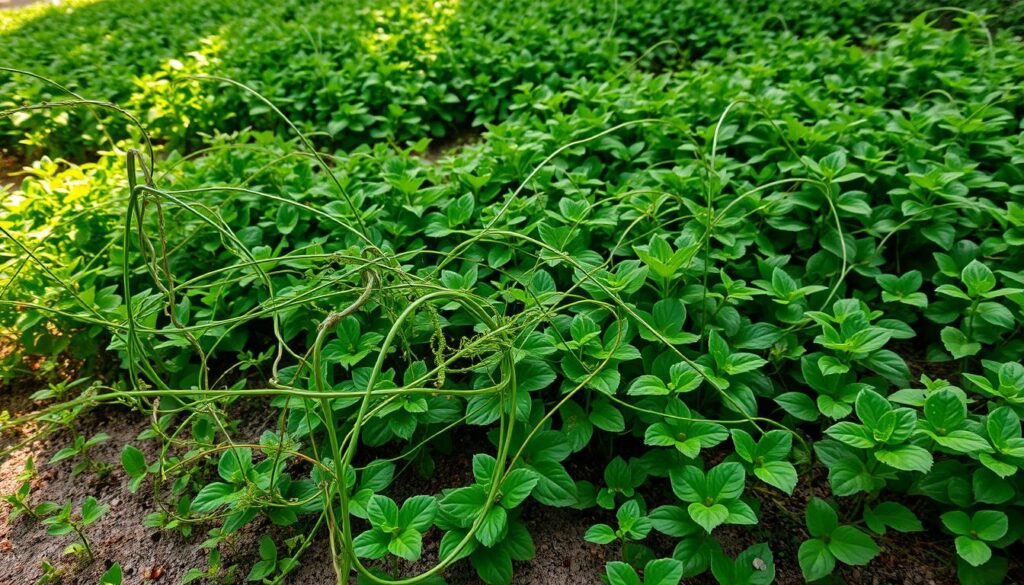
Carpet plants, like perennial ground covers, can be grown from stem cuttings or division. This means cutting a stem section from the parent plant or digging up the whole plant to separate the roots. These methods help you grow new plants that will flourish under your care.
To begin, pick the best method for your carpet plant. Think about the plant’s type and needs. With a bit of practice and patience, you’ll become great at growing carpet plants. They offer many benefits to enjoy.
Mistakes to Avoid with Carpet Plants
When caring for carpet plants, common mistakes can harm them. To create a beautiful garden carpet, knowing these pitfalls is key. Overwatering is a big issue, leading to root rot and death. Also, picking the wrong spot is a mistake, as carpet plants need specific light and temperature.
To avoid these errors, consider these tips:
- Check the soil moisture before watering to prevent overwatering
- Place your carpet plants in a spot with suitable lighting and temperature conditions
- Research the specific needs of your carpet plant species to ensure you’re providing the best care
By avoiding these mistakes, your carpet plants can flourish. Choose the right plant for your garden and research its needs. This way, you’ll give them the best care.

Seasonal Care for Carpet Plants
As you care for your carpet plants, remember the seasons change. This affects your plants’ needs. Whether they’re ground cover, dense foliage, or creeping plants, adjust their care with the seasons.
In spring and summer, your plants need more water and food. As the days get shorter, change their care to keep them healthy. For example, water and feed less in fall as growth slows.
In winter, water less since plants are dormant. The right care in each season keeps your plants healthy all year. Here are some winter tips:
- Water once a month, or as needed
- Give bright, indirect light for photosynthesis
- Keep a consistent temperature of 65-75°F (18-24°C)
Follow these tips and adjust your plants’ care with the seasons. This way, they’ll keep thriving and add beauty to your home or garden.
Where to Buy Carpet Plants
Ready to add a lush carpet plant to your indoor space? You have several great options. Local nurseries and garden centers carry many carpet plant species. You can see and touch the plants before buying.
The staff at these places can give you valuable advice on caring for your new plant. They know a lot about the plants they sell.
Online retailers are also a good choice. They offer a wide selection of carpet plants that can be delivered to your door. Many online stores specialize in indoor plants. They provide detailed information on each variety’s needs and growth habits.
This is especially helpful for beginners or those looking to try something new. Whether you like the in-person experience or online shopping, you can find the perfect carpet plant. With the right care, these plants can thrive and make your indoor space lush and verdant.
FAQ
What are carpet plants?
Carpet plants are low-growing plants that spread out. They cover large areas and fill small spaces. They create a dense mat of foliage.
What are some popular types of carpet plants?
Popular carpet plants include creeping thyme, sedum, and phlox. Each has different textures, colors, and growth habits.
How do carpet plants benefit indoor spaces?
Carpet plants purify the air by removing toxins. They make any space look natural and welcoming.
What are the ideal conditions for carpet plants?
Carpet plants like well-drained soil and partial shade to full sun. They do best in temperatures between 65°F to 75°F. They also need humidity that’s not too high or too low.
How do I care for my carpet plant?
To care for carpet plants, water them right and use well-draining mix. Use a balanced fertilizer during the growing season. Avoid overwatering to prevent root rot.
What are some common pests and diseases that affect carpet plants?
Spider mites, mealybugs, and root rot are common problems. Overwatering or poor soil can cause root rot. Regular checks and prevention can help.
How can I incorporate carpet plants into my home decor?
Use carpet plants to create a lush carpet underfoot. Hang them from baskets for wall greenery. They can also be a centerpiece for tables. Mixing them with other plants creates unique displays.
How do I propagate my carpet plant?
You can propagate carpet plants with stem cuttings or division. Both methods need careful attention to new plants. Make sure they get enough water and light until they’re established.
What are some common mistakes to avoid with carpet plants?
Avoid overwatering and choosing the wrong location. These mistakes can harm your carpet plants. Staying away from these errors keeps your plants healthy.
How do I care for my carpet plant throughout the seasons?
Adjust your care for carpet plants with the seasons. In spring and summer, they need more water and fertilizer. In fall and winter, adjust their care for their dormant state.
Where can I find carpet plants to purchase?
Find carpet plants at local nurseries and garden centers. Online retailers also sell them. The staff can offer great advice on care and maintenance.
Source Links
- Experts Say These Indoor Plants Can Add Style And Fresh Air To Your Home – https://www.womenshealthmag.com/life/g26610281/best-indoor-plants/
- Carpet Moss for Sale – Lush, Green Ground Cover Plants – https://www.tnnursery.net/products/carpet-moss
- Top 23 Houseplants for Apartment Living – https://www.apartmentguide.com/blog/best-houseplants-for-your-apartment/
- The Best Carpeting Plants for a Planted Tank – https://aquaessentials.co.uk/blogs/news/the-best-carpeting-plants-for-a-planted-tank
- Best Carpet Plants For Low Light Aquarium: A Comprehensive Guide – https://blog.cantonaquatics.com/blog/aqua-eden-chronicles/carpet-plants-for-low-light-aquariums-a-comprehensive-guide
- The Best Carpeting Aquarium Plants – https://glassgrown.com/blogs/learn-with-me/the-best-carpeting-aquarium-plants?srsltid=AfmBOoq46cGDz1CG3tzv4i8-kJv9SbudQLuG57srCXSWB4XzA8ZuUtyo
- Growing Low Tech Carpet Plants – https://www.liverpoolcreekaquariums.com.au/blogs/trending-topics/growing-low-tech-carpet-plants
- Creating The Best Planted Aquarium with These Carpeting Plants – https://splashyfishstore.com/blogs/care-guide-for-live-aquarium-plant/creating-the-best-planted-aquarium-with-these-carpeting-plants?srsltid=AfmBOoq6XbNha5ReHR2jrPjXLUzfnJCgLkVdFO2tV7u21moEuMZrz5sQ
- How To Grow Carpeting Plants in Any Type of Aquarium – https://buceplant.com/blogs/aquascaping-guides-and-tips/how-to-grow-carpeting-plants-in-low-high-tech-setups?srsltid=AfmBOoq4l5ekgJv69GNNOOU47YmUHpsKAwqcLwPkwM9b7tsPuA60iisW
- How to grow carpet plants without injected CO2 – https://www.2hraquarist.com/blogs/freshwater-aquarium-plants-guide/carpeting-plants?srsltid=AfmBOorR8jg6j3nPvSdN2dcw2nWm4ohkEL4YOLL7wACN3CrHpuDMj3ZU
- How To Grow Carpeting Plants in Any Type of Aquarium – https://buceplant.com/blogs/aquascaping-guides-and-tips/how-to-grow-carpeting-plants-in-low-high-tech-setups?srsltid=AfmBOopXzR9rEcAF_pxMriHcbxx-ARDvF9k3iv-MCXh1Xp4Eu8FXWHyO
- How to grow carpet plants without injected CO2 – https://www.2hraquarist.com/blogs/freshwater-aquarium-plants-guide/carpeting-plants?srsltid=AfmBOopNuKcq1rWMIB2UlGxY1Z08psab7EqSNfBG2Codr00xYqjm1iEE
- Lilaeopsis Brasilensis Care: Tips for a Thriving Carpet Plant – https://aqualandpetsplus.com/lilaeopsis-brasilensis/
- Common Persian Carpet Flower Problems – https://greg.app/persian-carpet-flower-problems/
- Ultimate Guide to Solving Carpet Rose Problems 🌹 – https://greg.app/carpet-rose-problems/
- 9 Best Aquarium Carpet Plants for Beginners – https://light.fish/blog/best-aquarium-carpet-plants
- How to Properly Grow Aquarium Carpet Plants – https://buceplant.com/blogs/aquascaping-guides-and-tips/how-to-properly-grow-aquarium-carpet-plants?srsltid=AfmBOopVZiSphqedzT4kfjrYO3H97LdNNM8BZ6GS8RmBDkDmDccOYe3x
- Carpet plants that get all their nutrients from the… – https://www.plantedtank.net/threads/carpet-plants-that-get-all-their-nutrients-from-the-water-column.196617/
- How to grow carpet plants without injected CO2 – https://www.2hraquarist.com/blogs/freshwater-aquarium-plants-guide/carpeting-plants?srsltid=AfmBOoqbVM0Lg1Tjn7q2McH-K-Tom1O6JkQciLykIeTOeRY0kJ27ZDfk
- Elatine Hydropiper Care Guide: Tips for Growing Carpet Plants – https://aqualandpetsplus.com/elatine-hydropiper/
- CARPETING YOUR AQUARIUM? AVOID THESE ANIMALS — Indoor Ecosystem – https://www.indoorecosystem.net/guides/carpeting-your-aquarium-avoid-these-animals
- 9 Common Planted Aquarium Mistakes to Avoid – https://buceplant.com/blogs/aquascaping-guides-and-tips/9-common-planted-aquarium-mistakes-to-avoid?srsltid=AfmBOoqzKWigRfktz0F37KSnA9LZlEXRXmqPQiOM7yldVsLKz-ImdiKI
- How to grow carpet plants without injected CO2 – https://www.2hraquarist.com/blogs/freshwater-aquarium-plants-guide/carpeting-plants?srsltid=AfmBOoqRC26JCkGaczKXSRGgzLdqSWtWfQRNf6E3Ly6D7K7O4vKwmy7K
- 🌸 6 Secrets to Successfully Grow Persian Carpet Flower – https://greg.app/how-to-grow-persian-carpet-flower/
- What is Carpetgrass? (Plus Pros, Cons, and Seeding Tips) – https://www.lawnstarter.com/blog/lawn-care-2/what-is-carpetgrass/
- How to grow carpet plants without injected CO2 – https://www.2hraquarist.com/blogs/freshwater-aquarium-plants-guide/carpeting-plants?srsltid=AfmBOoq6kurp_n-4HHYsIbEFKfq15xTCfZy4TIWbyONitPkOjwP0YmIa
- Top Picks: Best Low Light Aquarium Carpet Plants – https://blog.cantonaquatics.com/blog/aqua-eden-chronicles/top-picks-best-low-light-aquarium-carpet-plants

